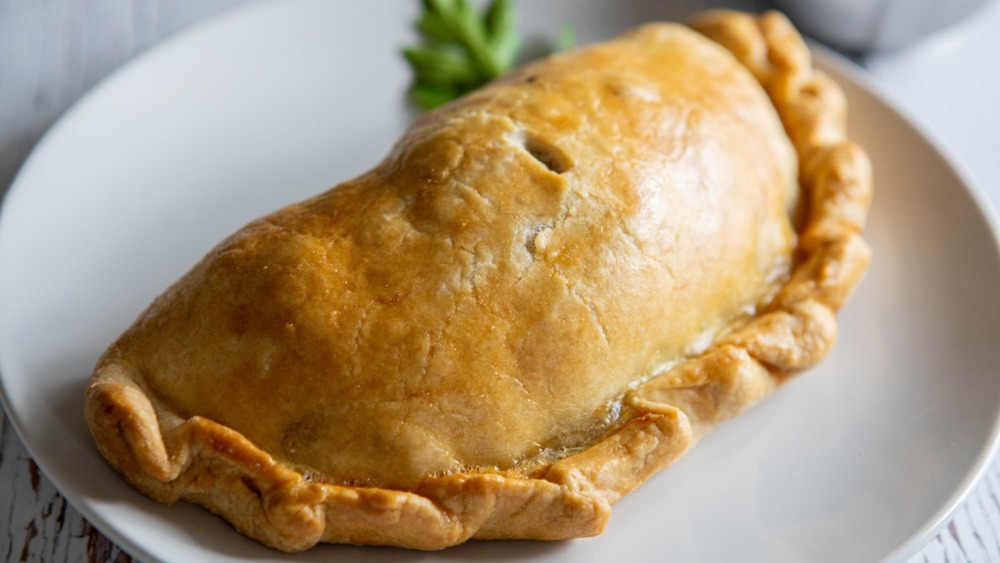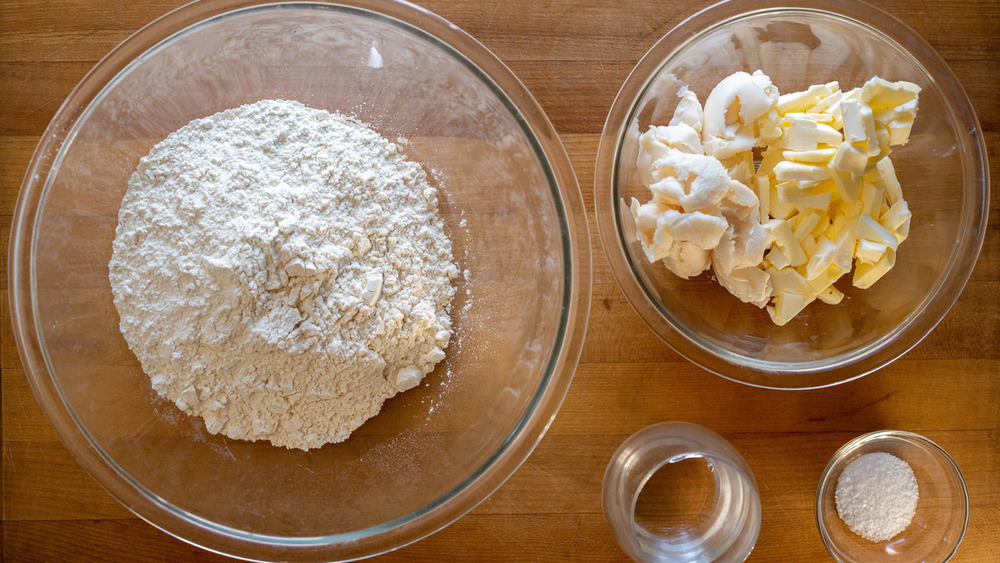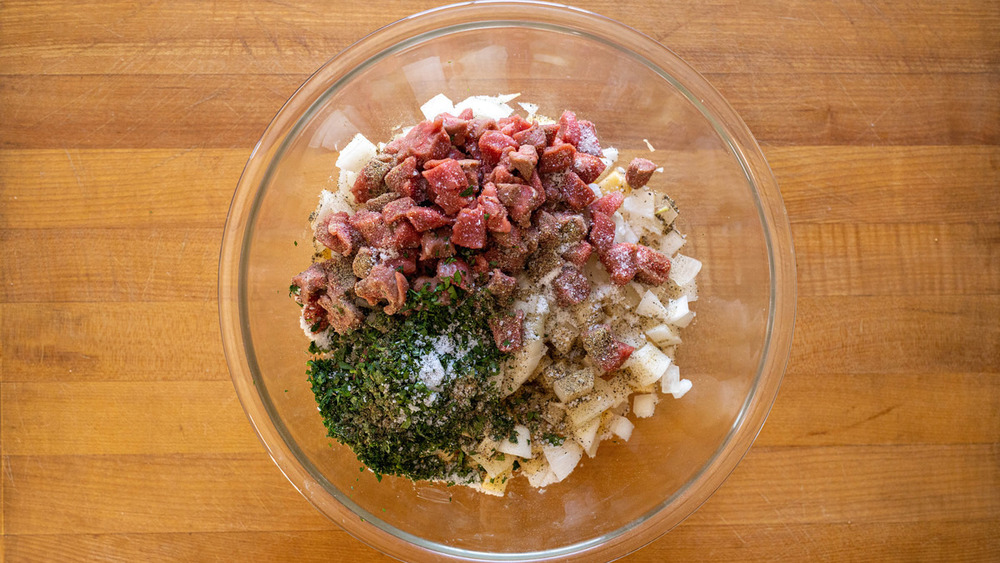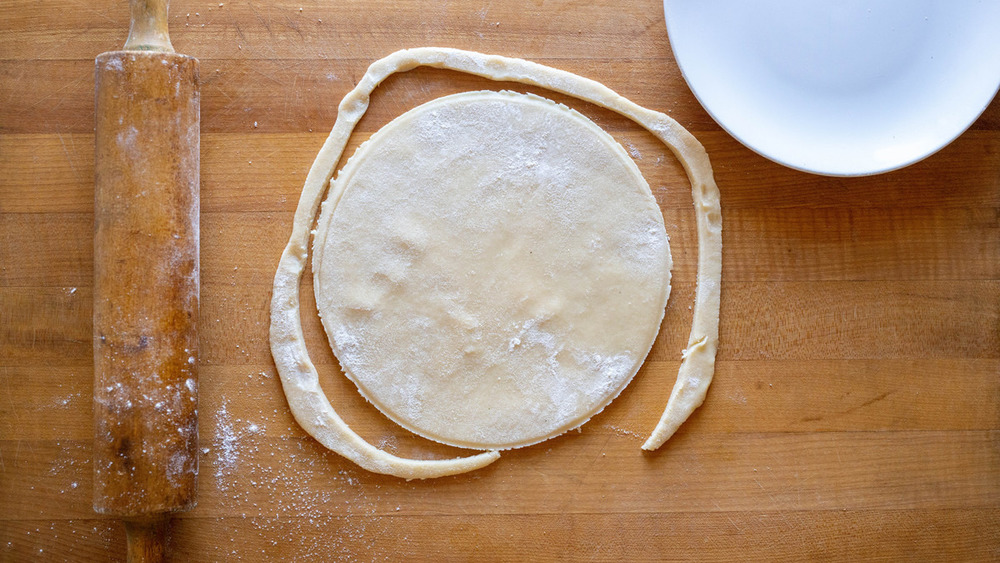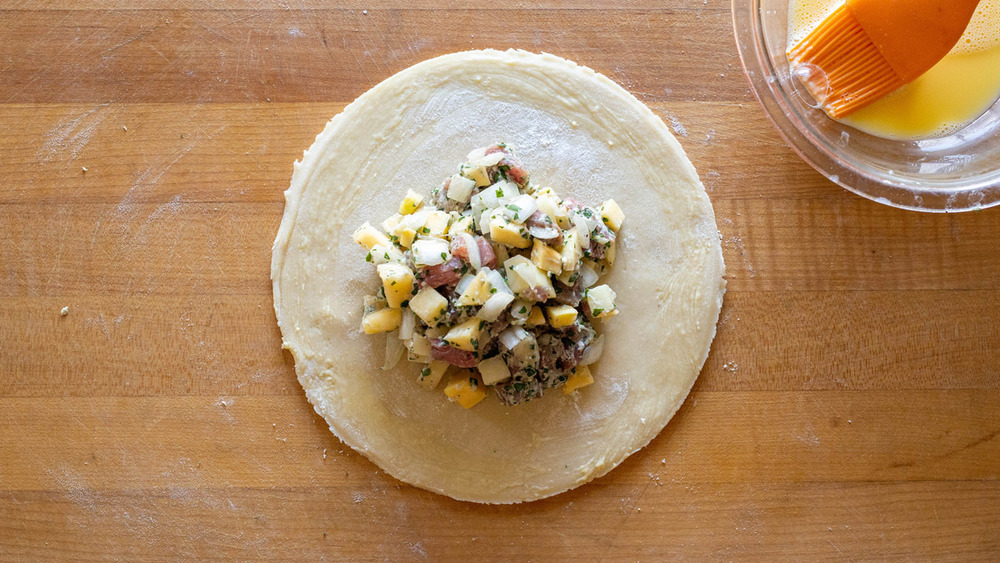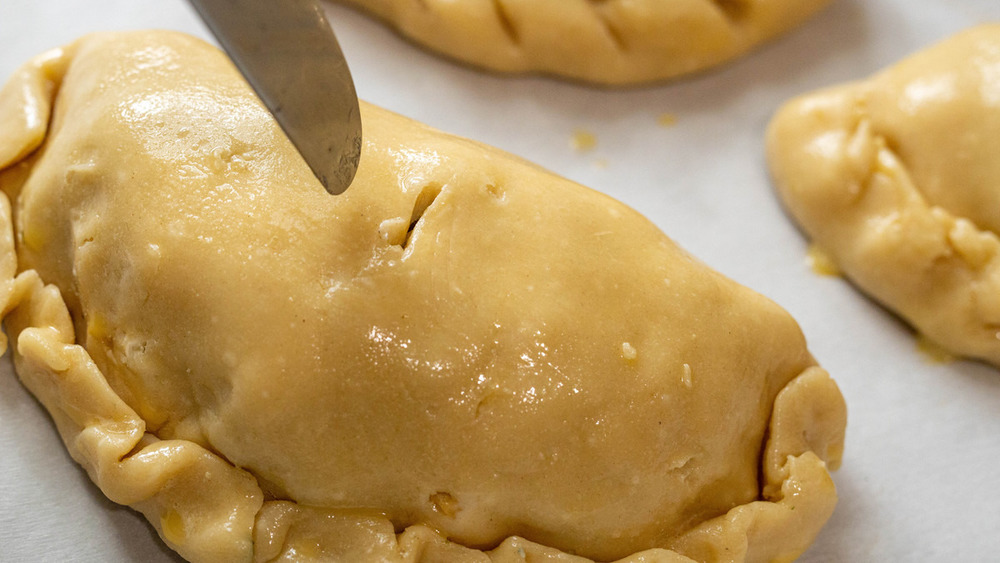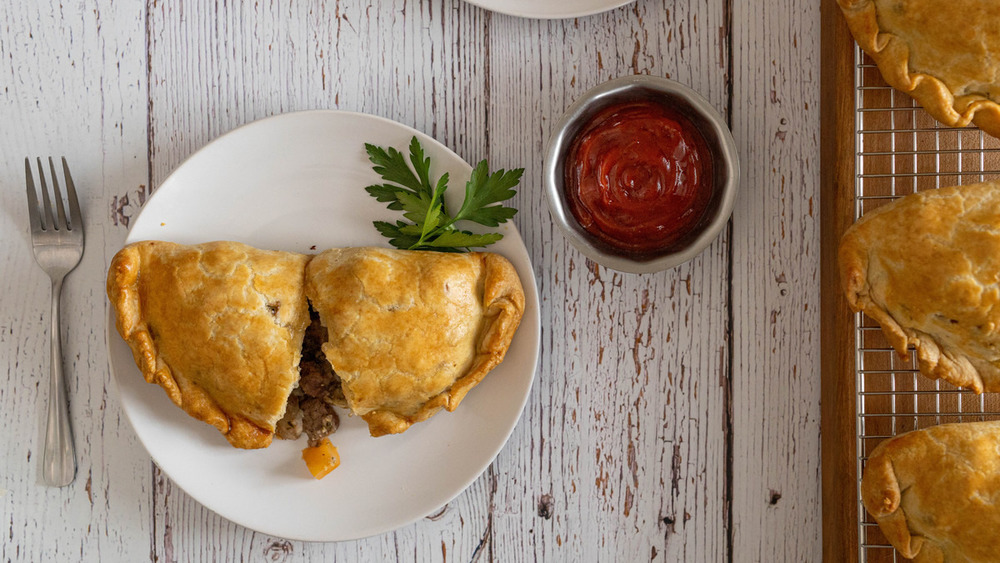Authentic Pasties Recipe
Pasties, which are actually pronounced PASS-tees, originated in Cornwall. The History Channel says that by the 1840s, Cornish miners had brought their favorite finger food over to Michigan's Upper Peninsula. There they were quickly adopted by the Finnish and Italian miners as well since they made for a highly portable and incredibly tasty meat, vegetable, and bread, all-in-one meal.
Keith Kamikawa, an animator, graphic designer, photographer and all-around renaissance man who has also worked as a chef, is a pasty connoisseur. Kamikawa is from Wisconsin himself, a state with no shortage of pasties, but says, "every time I go to the [Upper Penninsula] for camping [or] hiking, I always stop at the different pasty shops on the way there and back." For those of us unable to make periodic trips up north, Kamikawa created this super-authentic pasty recipe. It may be a little time-consuming, but the results are well worth the effort.
Start your pasties by making some dough
In order to make the dough for the pasties, you'll start with 4 cups all-purpose flour, then mix in a teaspoon of the salt and all of the butter and the lard or shortening. If you're the type who never remembers to soften your butter before baking, good news! In this recipe, both butter and lard should be fresh-from-the-fridge cold. Using your hands, mix all the ingredients together until the dough is coarse and flaky. Slowly pour in ⅔ cup water, a little at a time, until the dough forms a solid ball. Kamikawa notes that you may not need the entire amount of water depending on your kitchen's heat, humidity, and altitude. No need to perform complex calculations, though — just keep an eye on the dough and stop adding water when it looks right.
Take a ¼ cup flour and dust your cutting board or work surface. As with the water, Kamikawa says you may not need the entire amount of the flour for dusting. Knead the dough on your lightly-floured surface for 5 minutes until it's smoothed out a bit, then roll it into a log 3-inches in diameter. Wrap the log in plastic wrap, then set it in the refrigerator and let it chill for an hour.
Mix up the filling for your pasties
While your dough's chilling, it's time to mix the pasty filling. Trim the beef — sirloin is fine, though Kamikawa notes that skirt steak is more traditional, but he says, "Both work great!" Once you've removed any extraneous fat, dice the beef into small cubes (about ¼-inch thick). Peel and dice the potatoes (russets are recommended, as they are for most baking purposes), then do the same for the rutabagas and the onions. Chop the parsley for your pasties as well, then mix all the chopped meat and veggies with the black pepper and 2 teaspoons salt. Cover the bowl with plastic wrap and refrigerate it until the pasty's ready to go.
Roll the dough for your pasties
Take your dough log out of the fridge, unwrap it, then cut it into six equal parts. Should you happen to have a kitchen scale on hand, Kamikawa says each piece should weigh about 6 ½ ounces, but if you don't, you'll just have to eyeball it. Put 5 dough pieces back in the fridge, since you'll only be working with one at a time. Lightly dust your cutting board again, using a ¼ cup (or less) of flour. Let the dough sit for 5 minutes, then roll it into a circle about 8-inches in diameter and a little over an ⅛-inch thick.
If you want a nice pretty pasty, Kamikawa suggests taking an ⅛-inch plate and placing it on top of the rolled-out dough and using it as a template to trim the edges. Repeat the process until all 6 pasties are rolled out. You may wind up with about 5 ounces of leftover dough after rolling out all 6 pasties. Kamikawa suggests this can be used "for patching holes or decorative dough on the top of your pasties," though he says it can also be frozen for later use.
Time to put your pasties together
Take the bowl of filling out of the fridge, then stir in a ¼ cup flour to serve as a thickener. Kamikawa explains, "As the vegetables cook and the beef releases its juices, the filling binds together." Next, mix up a quick egg wash by whisking an egg with 2 tablespoons of cold water. Measure out 7 ½ ounces filling. If you have no kitchen scale, Kamikawa says just to eyeball a sixth of the filling. As he told us, "It wouldn't be the worst thing if one pasty had a little more filling than another. Just make sure you get the one with more!"
Place the pasties filling in the middle of a dough circle, brush the circle's edges with the egg wash, then fold the dough circle in half. Be sure to keep the filling in the middle where it belongs! Press the edges of the pasty together, then gently form and pack the filling so it makes a tight, firm lump. You may either crimp the pasty edges, roll up the edges of the dough towards the center, or use a fork to press the edges of the dough to make a nice tight seal. Repeat this process 6 times, but don't use up all of the egg wash since you'll be using it in the next step.
Time to bake your pasties
Preheat your oven to 375 F. While it's heating, line a baking sheet with parchment paper, and place the pasties on the sheet with an inch of space between each one. Brush the pasties with the remaining egg wash, then use a butter knife to cut a small hole in the top of each pasty right in the center. Kamikawa explains that these vent holes will allow the steam to escape as the pasties cook.
Bake the pasties for 50-60 minutes, rotating the pan one time about halfway through. When the pasties are done, they should be a nice golden brown. Use a spatula to remove the warm pasties from the baking sheet and transfer them to a cooling rack. They should cool for at least 10 minutes before you eat them, but they're delicious warm, at room temperature, or even cold.
Choose the condiments for your pasties wisely
Although Kamikawa says to serve the pasties with a side of ketchup, he admits that this may not be to everyone's taste. In fact, the way he describes the condiment issue is: "It's very controversial." Why is this? It's a regional thing. While people from northern Wisconsin are all on "team ketchup," he says that those from "the lower state" (a.k.a. southern Wisconsin) often prefer gravy. (Brown, not white!) In a kind of reverse snobbism, the ketchup eaters actually look down on the gravy eaters. Although Kamikawa is himself from Milwaukee (which is in the southeast corner of the state), he told us "I'm a classic [Upper Penninsula] ketchup guy for my pasties — gravy is a no no."
Pasties direcctions
Pasties may take some work, but this pasties recipe is totally worth it. Make it for family and friends when you seriously want to impress.
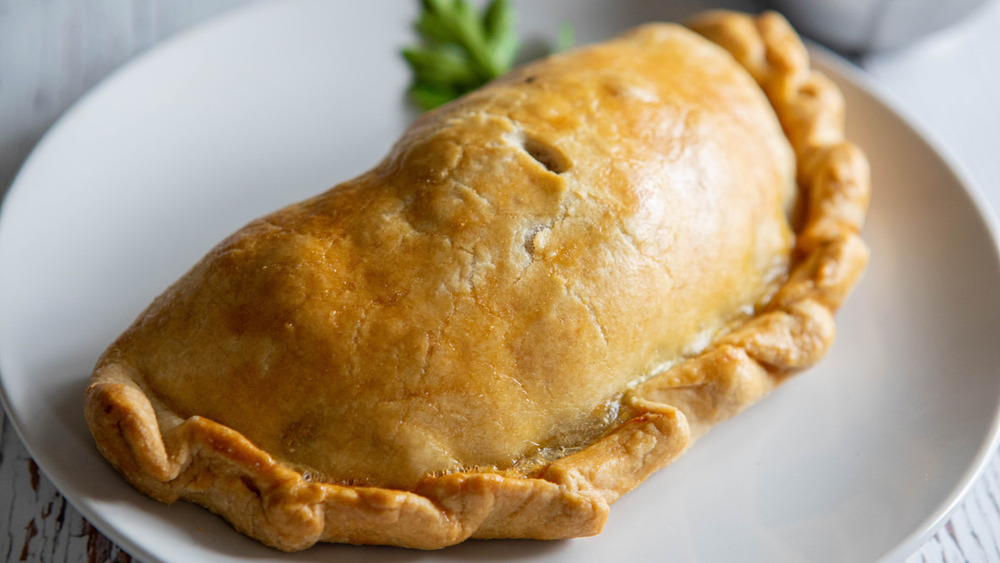
Ingredients
- 4 ½ cups all-purpose flour
- 6 ounces butter
- 6 ounces lard (or vegetable shortening)
- 3 teaspoons kosher salt
- 1 teaspoon black pepper
- 1 pound beef sirloin or skirt steak
- 12 ounces russet potatoes
- 10 ounces rutabaga
- 8 ounces white onion
- 1/2 ounce Italian parsley
- 2/3 cups plus 2 tablespoons water
- 1 egg
Directions
- Combine 4 cups flour, cold butter, cold lard (or shortening), and 1 teaspoon salt in a bowl. Use your hands to mix the ingredients together. The dough should be course and flaky. Slowly add 2/3 cup water a little at a time to form the dough into a solid ball (you might not need all of the water). Use ¼ cup of flour a little at a time to dust your cutting board while kneading the dough for 5 minutes (you might not need all of the flour). Once the dough has smoothed out, roll it into a 3-inch diameter log. Wrap the dough tightly in plastic wrap and refrigerate for an hour.
- Trim and dice beef, and peel and dice potato, rutabaga, and onion. Course chop parsley and combine all ingredients into a bowl with 2 teaspoons kosher salt and black pepper. Once combined, cover your bowl in plastic wrap and refrigerate until your dough is ready.
- Cut your dough log into 6 equal parts. These should weigh about 6 ½ ounces. Work with one piece of dough at a time, and keep the rest in the refrigerator. Use ¼ cup of flour for dusting your cutting board (the leftover flour from when you kneaded the dough). Let the dough sit for 5 minutes and then roll it into what will be roughly an 8-inch circle a little more than an eighth of an inch thick. Take an 8-inch plate, place it over the dough, then use a knife to trim the dough around the plate to make a nice circle. There will be approximately 5 ounces of dough left over after all of the pasties are made. Save extra dough for patching holes or decorations on top of your pasties, or freeze for later use.
- Take the bowl of filling out of the refrigerator and add ¼ cup flour. Mix well. Make egg wash by whisking an egg with 2 tablespoons of cold water. Measure out 7 1/2 ounces of filling and place it in the middle of the dough circle. Brush the edges of the dough circle with the egg wash. Fold the dough circle in half, carefully keeping the filling packed in the middle. Press the edges together and softly pack and form the filling in the dough so it's tight. Crimp, roll, or use a fork to press the dough edges together.
- Heat the oven to 375 degrees Fahrenheit. Place pasties on a parchment paper-lined baking sheet with one inch of space between each. Brush pasties with egg wash and cut one small hole in the top center of the each one. Bake for 50 minutes to one hour, rotating the pan once halfway through. Once pasties are golden, use a spatula to transfer to cooling rack. Cool for 10 minutes before serving with a side of ketchup (or gravy, if you must).
Nutrition
| Calories per Serving | 1,052 |
| Total Fat | 63.9 g |
| Saturated Fat | 30.5 g |
| Trans Fat | 0.9 g |
| Cholesterol | 173.5 mg |
| Total Carbohydrates | 89.9 g |
| Dietary Fiber | 5.2 g |
| Total Sugars | 4.4 g |
| Sodium | 951.3 mg |
| Protein | 28.1 g |
